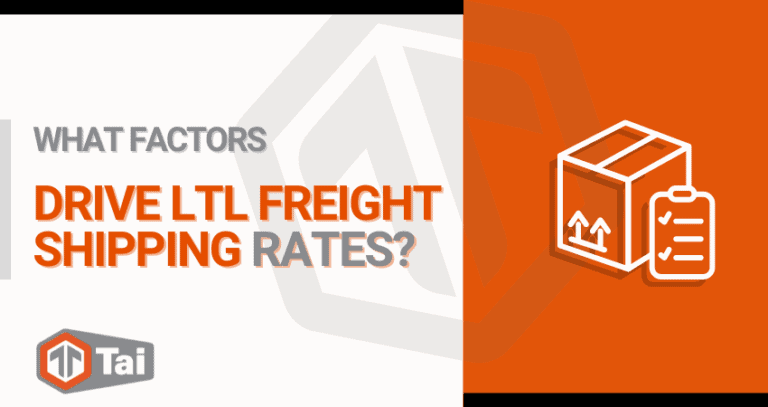Many businesses need to know how to control and manage their freight spend. Freight shipping is a complex process, and many questions need to be answered for everything to run smoothly. One of these commonly asked questions is about Less-than-Truckload freight rates and the factors that influence them. Knowing the answer to this question will allow LTL shippers, freight brokers, LTL freight carriers, and other stakeholders in the industry develop better logistics strategies, lower costs, and increase profitability.
The better the LTL freight rates are understood, the easier it will be to manage expectations and prepare the freight shipment processes, which will provide long-term resources and cost-saving benefits. For this reason, we’ll be taking a look at the factors that influence LTL freight rates so that you can better control the costs of your LTL freight shipping.
LTL Freight Rate Influencers
An average LTL shipment will tend to weigh somewhere between 151 and 20,000 lbs. As the freight moves up in weight, your typical LTL freight carrier will tend to apply discounts on shipments. This means that there are various so-called weight break discounts that an LTL carrier can provide.
Shipments that are larger than 5 pallets can still be shipped with an LTL carrier. However, these are usually considered volume moves and are spot quoted by the carrier.
It should go without saying that LTL freight rates can be pretty confusing. Unlike FTL shipment rates, which are typically based on a per-mile or per-hundredweight and a fuel charge, the LTL freight rate is regulated by many factors. Together, these will have a significant impact on the overall cost of the shipment.
The LTL shipping mode is used for shipments and parcels that are too large to be sent, but too small to fill an entire truck (full truckload). An LTL carrier collects freight from multiple shippers and consolidates that freight onto trailers for line-haul to either the delivery or hub terminal. Here, the freight will be further sorted and consolidated for additional line-hauls.
In most cases, truck drivers will start their day by loading up the cargo and heading out to make their deliveries. Once that’s finished and the trailer has been emptied, they’ll start making pickups and return them to the terminal for sorting and future delivery. Therefore, most pickups occur in the afternoon, while deliveries typically happen during the first half of the day.
Weight, Density, and Freight Classification
With parcel carrier shipping, trucking rates are typically calculated based on the package weight and travel distance. Taking these factors into consideration, LTL freight rates work differently. To start, we have three interconnected factors that influence the LTL freight rate. These include the following:
- Weight – LTL rates are calculated so that the more shipments weigh, the less the LTL freight costs per hundred pounds. As the LTL shipment weight increases and comes closer to the lowest weight in the next heaviest group, it will be rated as the lowest weight category and rate in that weight group.
- Density – The density of a shipment also plays a major role in determining the LTL rate. Shippers and freight brokers alike need to know how to determine a shipment’s density so that they can describe it in the bill of lading. The total weight of the shipment is divided by the total cubic feet to determine the overall density.
- Freight Classification – LTL freight classification plays a critical role in calculating rates. The different classes are published by the National Motor Freight Traffic Association (NMFTA) in the National Motor Freight Classification (NMFC) book. The NMFTA has 18 established classes that range from 50 to 500. These classes are determined based on freight density, value, stow-ability, handling, and liability. The lower the LTL freight class, the denser the cargo. The lower LTL freight class is usually easy to handle and difficult to damage. As such, lower classes have lower rates. Higher classes, on the other hand, are lighter and typically take up more space.
As you can see, these three factors are interconnected. The weight of the cargo determines its density, which, in turn, dictates the freight class. LTL freight carriers use the freight class to help determine the shipping rate for certain types of freight. It can be difficult to properly assess the freight class in the bill of lading and the freight quote, resulting in quite large billing adjustments down the line when the carrier does its own measurements. Any discrepancies will lead to changes in billing.
Distance
The next most important factor in determining shipping rates is distance. Typically, the longer the haul, the higher the price per hundred pounds will be. It’s also important to keep in mind that many LTL carriers only service a local geographic region instead of a national one.
Therefore, you will need to consider how many Zip Codes a carrier will service directly. If your shipment is sent outside of their area, the trucking company in question will transfer your shipment to another LTL carrier. Depending on the exact distance, this process (interlining) can happen more than once. Interlining can often lead to higher costs due to lower discounts and higher minimum charges.
Capacity
Another factor that can affect freight rates is LTL capacity. To fulfill capacity and efficiently use the space in their trailers, carriers may need to charge differently for certain lanes. This difference is largely based on supply and demand. This is because they need to account for solving LTL capacity issues in terms of backhaul, deadhead, and headhaul.
Base Rates
Every LTL carrier establishes its own base rates. These are quoted per 100 pounds (hundredweight – CWT). As expected, the base rate will vary from one carrier to the next, and from one lane to another. The CWT is calculated based on the freight classification mentioned above. As a general rule of thumb, carriers will also tend to change their base rates based on their need for extra volume and increase in gross costs for lanes that have a good balance between freight and available trucks.
Freight All Kinds (FAK)
This is an arrangement between stakeholders where they agree that different freight classes be shipped and billed under the same freight class. If, for instance, a shipper wants to haul multiple commodities ranging from 50 to 150, they could negotiate a FAK to rate all items at class 70. This arrangement can help streamline operations and reduce the cost associated with higher class shipments.
Negotiated Rate Tariffs
Negotiation with several LTL carriers per various lanes is also possible. This will allow both shippers and freight brokers to get better tariffs for different lanes by balancing the more unattractive lanes with the more attractive ones and giving better overall freight rates.
Discounts
Shippers can also take advantage of further discounts on LTL rates if they work together with 3PLs or freight brokers. These professionals typically have negotiated heavy discounts with carriers due to their frequent shipments to multiple locations and their work with numerous freight carriers.
Accessorials and Surcharges
Accessorial surcharges come from any extra services provided by the carrier that goes beyond the typical dock-to-dock pickup and delivery. Among these, we can include things such as residential pickups or deliveries, lift gate services, limited access locations, inside delivery, and more. These additional charges can be negotiated to a flat rate or even waived. Fuel surcharges are the most common accessorials that are factored into shipments.
The Four Seasons of Freight Shipping
As mentioned previously, carriers will try to fulfill their capacity and fill their space on every lane. When they are dealing with scarce supply, rates are more competitive. Yet, when there are plenty of shipments to move, truck space becomes a valuable commodity and rates tend to go up.
This is especially true during the so-called Four Seasons of Freight Shipping. The fresh produce industry drives demand for freight shipping during spring and summer. The winter holidays drive shipping in November and December, while January to March freight volume is typically low.
Takeaway
At the end of the day, freight rates are mostly influenced by supply and demand. Through the use of state-of-the-art digital tools, freight brokers stand a much better chance of getting the best deals possible.
Tai Software is one such freight broker software that provides its users with all the features necessary to manage their loads. It’s a cloud-based solution that uses Artificial Intelligence (AI) to facilitate its users with a centralized location from which they can automate their shipping, rating, and accounting processes. Load boards and carriers are integrated directly into the TMS so that the broker isn’t jumping from platform to platform. In doing so, Tai Software makes it that much easier for freight brokers to scale their operations. Request a free demo today!










